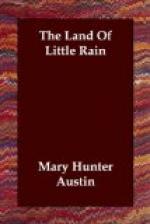With the water runs a certain following of thirsty herbs and shrubs. The willows go as far as the stream goes, and a bit farther on the slightest provocation. They will strike root in the leak of a flume, or the dribble of an overfull bank, coaxing the water beyond its appointed bounds. Given a new waterway in a barren land, and in three years the willows have fringed all its miles of banks; three years more and they will touch tops across it. It is perhaps due to the early usurpation of the willows that so little else finds growing-room along the large canals. The birch beginning far back in the canon tangles is more conservative; it is shy of man haunts and needs to have the permanence of its drink assured. It stops far short of the summer limit of waters, and I have never known it to take up a position on the banks beyond the ploughed lands. There is something almost like premeditation in the avoidance of cultivated tracts by certain plants of water borders. The clematis, mingling its foliage secretly with its host, comes down with the stream tangles to the village fences, skips over to corners of little used pasture lands and the plantations that spring up about waste water pools; but never ventures a footing in the trail of spade or plough; will not be persuaded to grow in any garden plot. On the other hand, the horehound, the common European species imported with the colonies, hankers after hedgerows and snug little borders. It is more widely distributed than many native species, and may be always found along the ditches in the village corners, where it is not appreciated.
The irrigating ditch is an impartial distributer. It gathers all the alien weeds that come west in garden and grass seeds and affords them harbor in its banks. There one finds the European mallow (Malva rotundifolia) spreading out to the streets with the summer overflow, and every spring a dandelion or two, brought in with the blue grass seed, uncurls in the swardy soil. Farther than either of these have come the lilies that the Chinese coolies cultivate in adjacent mud holes for their foodful bulbs. The seegoo establishes itself very readily in swampy borders, and the white blossom spikes among the arrow-pointed leaves are quite as acceptable to the eye as any native species.




